Increased survival and reduced neutrophil infiltration of the liver in Rab27a- but not Munc13-4-deficient mice in lipopolysaccharide-induced systemic inflammation
- PMID: 21746860
- PMCID: PMC3165471
- DOI: 10.1128/IAI.05043-11
Increased survival and reduced neutrophil infiltration of the liver in Rab27a- but not Munc13-4-deficient mice in lipopolysaccharide-induced systemic inflammation
Abstract
Genetic defects in the Rab27a or Munc13-4 gene lead to immunodeficiencies in humans, characterized by frequent viral and bacterial infections. However, the role of Rab27a and Munc13-4 in the regulation of systemic inflammation initiated by Gram-negative bacterium-derived pathogenic molecules is currently unknown. Using a model of lipopolysaccharide-induced systemic inflammation, we show that Rab27a-deficient (Rab27a(ash/ash)) mice are resistant to lipopolysaccharide (LPS)-induced death, while Munc13-4-deficient (Munc13-4(jinx/jinx)) mice show only moderate protection. Rab27a(ash/ash) but not Munc13-4(jinx/jinx) mice showed significantly decreased tumor necrosis factor alpha (TNF-α) plasma levels after LPS administration. Neutrophil sequestration in lungs from Rab27a(ash/ash) and Munc13-4(jinx/jinx) LPS-treated mice was similar to that observed for wild-type mice. In contrast, Rab27a- but not Munc13-4-deficient mice showed decreased neutrophil infiltration in liver and failed to undergo LPS-induced neutropenia. Decreased liver infiltration in Rab27a(ash/ash) mice was accompanied by lower CD44 but normal CD11a and CD11b expression in neutrophils. Both Rab27a- and Munc13-4-deficient mice showed decreased azurophilic granule secretion in vivo, suggesting that impaired liver infiltration and improved survival in Rab27a(ash/ash) mice is not fully explained by deficient exocytosis of this granule subset. Altogether, our data indicate that Rab27a but not Munc13-4 plays an important role in neutrophil recruitment to liver and LPS-induced death during endotoxemia, thus highlighting a previously unrecognized role for Rab27a in LPS-mediated systemic inflammation.
Figures
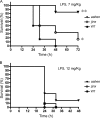

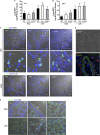
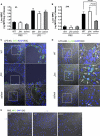
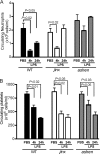


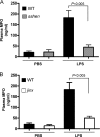
Similar articles
-
Munc13-4 restricts motility of Rab27a-expressing vesicles to facilitate lipopolysaccharide-induced priming of exocytosis in neutrophils.J Biol Chem. 2011 Feb 18;286(7):5647-56. doi: 10.1074/jbc.M110.184762. Epub 2010 Dec 9. J Biol Chem. 2011. PMID: 21148308 Free PMC article.
-
The Rab27a effectors JFC1/Slp1 and Munc13-4 regulate exocytosis of neutrophil granules.Traffic. 2008 Dec;9(12):2151-64. doi: 10.1111/j.1600-0854.2008.00838.x. Epub 2008 Oct 30. Traffic. 2008. PMID: 18939952 Free PMC article.
-
Rab27a and Rab27b regulate neutrophil azurophilic granule exocytosis and NADPH oxidase activity by independent mechanisms.Traffic. 2010 Apr;11(4):533-47. doi: 10.1111/j.1600-0854.2009.01029.x. Epub 2009 Dec 17. Traffic. 2010. PMID: 20028487 Free PMC article.
-
Molecular mechanisms regulating secretory organelles and endosomes in neutrophils and their implications for inflammation.Immunol Rev. 2016 Sep;273(1):249-65. doi: 10.1111/imr.12452. Immunol Rev. 2016. PMID: 27558339 Free PMC article. Review.
-
Versatile role of Rab27 in membrane trafficking: focus on the Rab27 effector families.J Biochem. 2005 Jan;137(1):9-16. doi: 10.1093/jb/mvi002. J Biochem. 2005. PMID: 15713878 Review.
Cited by
-
Escherichia coli Braun Lipoprotein (BLP) exhibits endotoxemia - like pathology in Swiss albino mice.Sci Rep. 2016 Oct 4;6:34666. doi: 10.1038/srep34666. Sci Rep. 2016. PMID: 27698491 Free PMC article.
-
Gene silencing of non-obese diabetic receptor family (NLRP3) protects against the sepsis-induced hyper-bile acidaemia in a rat model.Clin Exp Immunol. 2015 Feb;179(2):277-93. doi: 10.1111/cei.12457. Clin Exp Immunol. 2015. PMID: 25228381 Free PMC article.
-
Differential dysregulation of granule subsets in WASH-deficient neutrophil leukocytes resulting in inflammation.Nat Commun. 2022 Sep 21;13(1):5529. doi: 10.1038/s41467-022-33230-y. Nat Commun. 2022. PMID: 36130971 Free PMC article.
-
Nitric oxide-mediated apoptosis of neutrophils through caspase-8 and caspase-3-dependent mechanism.Cell Death Dis. 2016 Sep 1;7(9):e2348. doi: 10.1038/cddis.2016.248. Cell Death Dis. 2016. PMID: 27584786 Free PMC article.
-
A role for Rab27 in neutrophil chemotaxis and lung recruitment.BMC Cell Biol. 2014 Oct 31;15:39. doi: 10.1186/s12860-014-0039-z. BMC Cell Biol. 2014. PMID: 25359237 Free PMC article.
References
-
- Basit A., et al. 2006. ICAM-1 and LFA-1 play critical roles in LPS-induced neutrophil recruitment into the alveolar space. Am. J. Physiol. Lung Cell. Mol. Physiol. 291:L200–L207 - PubMed
-
- Beck-Schimmer B., et al. 2002. Role of alveolar epithelial ICAM-1 in lipopolysaccharide-induced lung inflammation. Eur. Respir. J. 19:1142–1150 - PubMed
-
- Beutler B., Milsark I. W., Cerami A. C. 1985. Passive immunization against cachectin/tumor necrosis factor protects mice from lethal effect of endotoxin. Science 229:869–871 - PubMed
Publication types
MeSH terms
Substances
Grants and funding
LinkOut - more resources
Full Text Sources
Molecular Biology Databases
Research Materials
Miscellaneous

